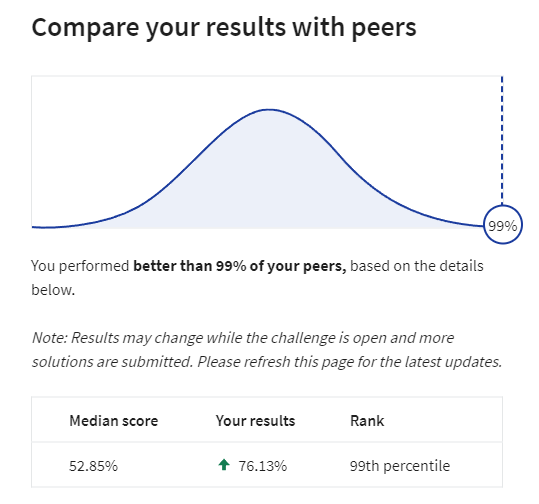Participated in Coursera's Data Science Coding Challenge to build a machine learning model to predict which individuals are at the highest risk of defaulting on their loan payments based on historical data of previous loans and their default rates. Typical data obtained during loan applications are provided, including age, income, loan amount, credit score, interest rate, loan term, employment type, co-signer, etc. The competition was held from August 29 to 31, 2023.
Participants were provided training datatset that contains default as a binary target outcome for training and validating, as well as a test dataset, without the default outcome. The predicted default outcomes for the test dataset was compared to the known ground truth hidden to the participants and automatically graded based on AUC metric when the predictions were uploaded to Coursera's servers.
My ensemble, hyperparameter tuned machine learning model built using AutoGluon, Pandas, Numpy and scikit-learn ranked 99th percentile with AUC score of 76.13% while median score amongst the 2,064 particpants (as of December 1, 2023) was 52.85%.

While at CFDRC's Computational Medicine and Biology (CMB) division, we were awarded a Chemical and Biological Defense (CBD) SBIR Phase II project to quickly, accurately and automatically perform respirator mask sizing and predict protective fit using only 2D images captured on smartphone cameras, thereby replacing the lengthy physical testing procedures and can even be performed in the field when needed. In Phase I, personalized 3D facial surfaces are generated through shape reconstruction in real-time from captured 2D images. Common facial anthropometric measurements are automatically extracted from the mesh and are then used to predict respirator mask size according to National Institute for Occupational Safety and Health (NIOSH) respirator test fit panels. Preliminary validation showed 5.1% facial anthropometric feature prediction error. Phase II will involve the development of individualized respiration models to simulate the movement of air and particulates through the mask and into the lungs in order to predict quantitative fit factor. Further validation studies will also be performed to ensure the accuracy of the app predictions.
While at CFDRC's Computational Medicine and Biology (CMB) division, we were awarded an Army SBIR Phase II project to develop a burn injury assessment tool with morphable 3D anthropometric human body models in order to improve the accuracy of percentage burn surface area estimates. This is a continuation of the work performed in Phase I where a functional prototype tool was created for real-time generation of an anthropometric 3D virtual human body with graphical annotations of burn areas and severity as well as assessment of percentage of total body surface area (%TBSA). For Phase II, the capabilities of the prototype will be expanded to develop a comprehensive tool. New functionalities will include a database to retrieve stored patient and burn information, addition of child model, full body model articulations for independent body parts scaling, and a specialized interfa ce for the hands given their high burn incidences. To further aid in image-assisted burn demarcation, a photograph acquisition guide for direct alignment with the 3D model on the mobile version of our tool will be developed along with infrared thermal image processing to estimate burn depth.
While at CFDRC's Computational Medicine and Biology (CMB) division, we were awarded a Chemical and Biological Defense (CBD) SBIR Phase I project to quickly, accurately and automatically perform respiratory mask sizing and predict protective fit using only 2D images captured on smartphone cameras, thereby replacing the lengthy physical testing procedures and can even be performed in the field when needed.
While at CFDRC's Computational Medicine and Biology (CMB) division, we were awarded an Army SBIR Phase I project to develop a burn injury assessment tool with morphable 3D anthropometric human body models in order to improve the accuracy of percentage burn surface area estimates. A functional prototype tool will be created for real-time generation of an anthropometric 3D virtual human body with graphical annotations of burn areas and severity as well as assessment of percentage of total body surface area (%TBSA).
While at CFDRC's Computational Medicine and Biology (CMB) division, we were awarded a 3 year Cooperative Agreement project (U01) with the U.S. Food and Drug Administration (FDA) to develop a multiscale-multiphysics modeling and simulation software tool for ocular drug delivery.